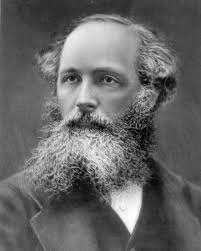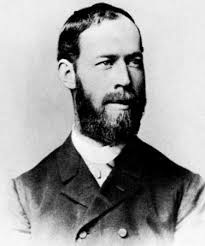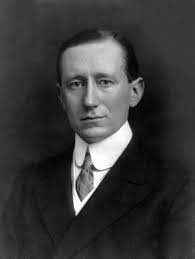
Maxwell’s Equations: However, Maxwell’s most important scientific contribution was to the field of electricity and magnetism: a set of differential equations which are now known asMaxwell’s equations, and describe the properties of electric and magnetic fields and their interactions with matter. Maxwell used his equations to show that electric and magnetic fields are two complementary components of electromagnetic fields. He also showed that electric and magnetic fields travel through empty space, in the form of waves, at a constant velocity of 3.0 × 108 m/s (which predicted the speed of light c) and also proposed that light was a form of electromagnetic radiation.
The Scottish physicist James Clerk Maxwell, b. Nov. 13, 1831, d. Nov. 5, 1879, did revolutionary work in electromagnetism and the kinetic theory of gases. After graduating (1854) with a degree in mathematics from Trinity College, Cambridge, he held professorships at Marischal College in Aberdeen (1856) and King’s College in London (1860) and became the first Cavendish Professor of Physics at Cambridge in 1871.
Maxwell’s first major contribution to science was a study of the planet Saturn’s rings, the nature of which was much debated. Maxwell showed that stability could be achieved only if the rings consisted of numerous small solid particles, an explanation still accepted. Maxwell next considered molecules of gases in rapid motion. By treating them statistically he was able to formulate (1866), independently of Ludwig Boltzmann, the Maxwell-Boltzmann kinetic theory of gases. This theory showed that temperatures and heat involved only molecular movement. Philosophically, this theory meant a change from a concept of certainty–heat viewed as flowing from hot to cold–to one of statistics–molecules at high temperature have only a high probability of moving toward those at low temperature. This new approach did not reject the earlier studies of thermodynamics; rather, it used a better theory of the basis of thermodynamics to explain these observations and experiments.
Maxwell’s most important achievement was his extension and mathematical formulation of Michael Faraday’s theories of electricity and magnetic lines of force. In his research, conducted between 1864 and 1873, Maxwell showed that a few relatively simple mathematical equations could express the behavior of electric and magnetic fields and their interrelated nature; that is, an oscillating electric charge produces an electromagnetic field. These four partial differential equations first appeared in fully developed form in Electricity and Magnetism (1873). Since known as Maxwell’s equations they are one of the great achievements of 19th-century physics.
Maxwell also calculated that the speed of propagation of an electromagnetic field is approximately that of the speed of light. He proposed that the phenomenon of light is therefore an electromagnetic phenomenon. Because charges can oscillate with any frequency, Maxwell concluded that visible light forms only a small part of the entire spectrum of possible electromagnetic radiation.

Heinrich Hertz was the first to send and receive radio waves. James Clerk Maxwell had mathematically predicted their existence in 1864. Between 1885 and 1889, as a professor of physics at Karlsruhe Polytechnic, he produced electromagnetic waves in the laboratory and measured their wavelength and velocity. He showed that the nature of their reflection and refraction was the same as those of light, confirming that light waves are electromagnetic radiation obeying the Maxwell equations.
All of these findings were first published in the journal Annalen der Physik,(see below right) then in Hertz’s first book, Untersuchungen Ueber Die Ausbreitung Der Elektrischen Kraft (Investigations on the Propagation of Electrical Energy), shown at right. His book is considered to be one of the most important works of science. This is where he first describes his confirmation of the existence of electromagnetic waves.
Annalen der Physik und Chemie is one of the oldest physics journals worldwide. The journal, still in publication today, publishes original papers in the areas of experimental, theoretical, applied and mathematical physics and related areas.
Hertz’s Experiment:
 |
There are 12 complete volumes of Annalen der Physik und Chemie in my collection. Included are Hertz’s many papers proving the Maxwell hypothesis on the propagation of electromagnetic waves. These papers laid the foundation for the development of radio and electromagnetic wave transmission applications. Also included are more Hertz papers plus others by Roentgen, Planck, Boltzmann, Angstrom, Helmholtz.
 |
|
|
Early experimental Hertz radiator and resonator for creating and detecting Hertzian waves |
Maxwell used the later-abandoned concept of the ether to explain that electromagnetic radiation did not involve action at a distance

Radio owes its development to two other inventions, the telegraphand the telephone, all three technologies are closely related. Radio technology began as “wireless telegraphy”.
Radio can refer to either the electronic appliance that we listen with or the content listened to. However, it all started with the discovery of “radio waves” – electromagnetic waves that have the capacity to transmit music, speech, pictures and other data invisibly through the air. Many devices work by using electromagnetic waves including: radio, microwaves, cordless phones, remote controlled toys, television broadcasts, and more.
The Roots of Radio
During the 1860s, Scottish physicist, James Clerk Maxwell predicted the existence of radio waves; and in 1886, German physicist, Heinrich Rudolph Hertzdemonstrated that rapid variations of electric current could be projected into space in the form of radio waves similar to those of light and heat.
In 1866, Mahlon Loomis, an American dentist, successfully demonstrated “wireless telegraphy.” Loomis was able to make a meter connected to one kite cause another one to move, marking the first known instance of wireless aerial communication.
Guglielmo Marconi
Guglielmo Marconi, an Italian inventor, proved the feasibility of radio communication. He sent and received his first radio signal in Italy in 1895. By 1899 he flashed the first wireless signal across the English Channel and two years later received the letter “S”, telegraphed from England to Newfoundland. This was the first successful transatlantic radiotelegraph message in 1902.
Guglielmo Marconi is known to have transmitted the first radio signal across the Atlantic, launching the wireless-communications industry. He did more developments on the radio technology than any other inventor, hence being called Father of Radio. He was very much interested in Hertzian Waves and it was in 1897, that his advanced system was used to test if it could provide a reliable link across various stretches of water.
